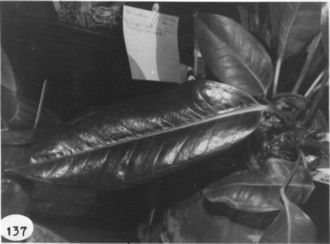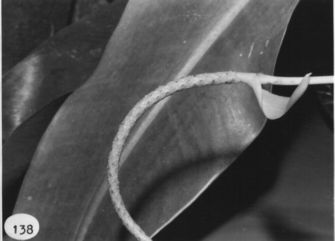



Anthurium pirrense Croat, sp. nov.
TYPE: Panama. Darien: Serrania de Pirre, ca. 12 km N of Alturas de Nique, lower montane rain forest, 1,520-1,560 m, Croat 37900 (MO 2400316, holotype; F, GH, K, PMA, SEL, US, isotypes; Live at MO).
Planta epiphytica; cataphyllum subcoriacea, basi findens, apicc persistens intactum; petiolus subteres, leviter sulcatus, 12-31 cm longus; lamina modice coriacea, lanceolata ad oblongo-elliplica, basi obtusa ad rotundata, 20-29 cm longa, 8-12 cm lata; pagina inferiore glanduloso-punctata; inflorescentia effusa; pedunculus interdum leviter costatus, 19-48 cm longus; spatha subcoriacea, pallide viridis, lanceolata, 5-6.5 cm longa, 1.3-1.5 cm lata, spadix viridis ante anthesin, aurantiacentes, 9-15 cm longus; baccae ignotae.
Epiphyte; stems short; leaf scars hidden by cataphylls; roots moderately thin, greenish, descending; cataphylls subcoriaceous, 4.5-5 cm long, minutely apiculate at apex, drying medium brown, splitting at base, persisting more or less intact at apex.
LEAVES erect-spreading; petioles 12-31 cm long, 6-7 mm diam., subterete, shallowly sulcate, the margins erect; geniculum 1.5-3 cm long; blades moderately thick, lanceolate to oblong-elliptic, abruptly acuminate at apex (the acumen downtumed), obtuse to rounded at base, 20-29 cm long, 8-12 cm wide, broadest below middle; both surfaces semiglossy, the lower surface much paler, dark glandular-puncate; midrib convexly raised above, diminishing and sunken toward apex, convexly raised below; primary lateral veins 7-8(-12) per side, departing midrib at 55¡ angle, sunken above, raised below, more or less straight to collective vein; interprimary veins weakly sunken above, prominulous below; lesser veins scarcely visible below; collective vein arising from near the base or from one of the lowermost primary lateral veins, sunken above, raised below, 5-7 mm from margin.
INFLORESCENCE spreading, equalling or longer than leaves; peduncle 19-48 cm long, 4÷ 5 mm diam., sometimes faintly ribbed; spathe medium thick, pale green (B & K Green 8/2.5), lanceolate, 5-6.5 cm long, 1.3-1.5 cm wide, broadest at base, the margins tightly turned under, sometimes twisting longitudinally, inserted at 70¡ angle on peduncle; decurrent to 9 mm; spadix green (B & K Yellow-green 8/10), turning orange-brown before anthesis, lengthening markedly during anthesis, 9-15 cm long, ca. 5 mm diam. near base, ca. 2 mm diam. near apex; flowers rhombic, 2.5 mm in both directions, the sides more or less straight, 5-6 flowers visible in the principal spiral, 7-9 visible in the alternate spiral; tepals glossy, minutely papillate, lateral tepals ca. 1.9 mm wide, the inner margins straight; pistils raised, pale yellow-green; stigma ovate, ca. 3 mm long; stamens emerging slowly, more or less scattered or beginning at the base, the lateral stamens emerging to apex before alternates appear, only tip of anthers exposed, anthers greenish white, 0.2-0.5 mm long, 0.5-0.7 mm wide, scarcely exposed, held at edge of pistil; thecae oblong, not divaricate; pollen white.
INFRUCTESCENCE not seen. Figs. 137 and 138.
Anthurium Pirrense is endemic to the Serrania de Pirre in western Darien Province of Panama. All collections have been made from the vicinity of the type locality in lower montane rain forest at 1,400 to 1,600 m.
The species, a member of section Porphyrochitonium, is distinguished by its epiphytic habit, its short stems with persistent, weathered cataphylls, its subterete petioles subequalling blades with a flat, erect-margined sulcus adaxially, and by its oblong-elliptic, subcoriaceous blades with the collective vein relatively remote from the margin. Also characteristic are its inflorescence subequalling leaves and its slender, orange-brown spadix with a purplish ring around the pistil (inner margin of tepals purplish). It is similar to Anthurium crassitepalum with which it occurs, but that species has thinner blades on drying and lacks the prominently raised collective vein of A. pirrense. More importantly, A. crassitepalum differs in having a greenish to yellow spadix with a "cobbled" appearance owing to its thickened, somewhat elevated tepals.
 |
 |
Darien: Serrania de Pirre, vicinity Alturas de Nique, Croat 37850, 37884, 37992, 37943, 37949 (MO), 37900 (F, GH, K, MO, PMA, SEL, US).